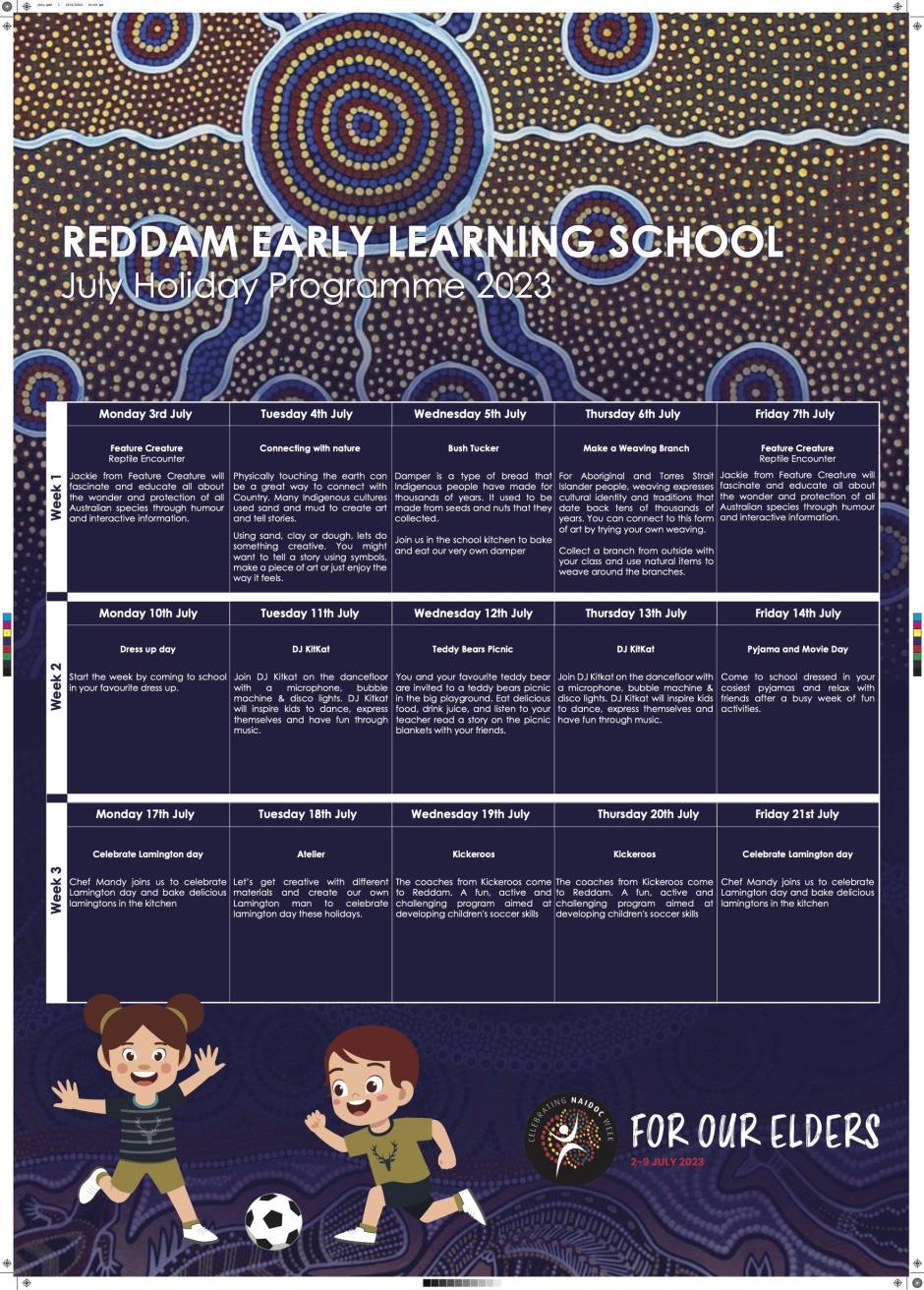Reddam ELS Woollahra Week 8

Dear Parents and Caregivers,

We can all probably testify to the fact that our lives are in a constant state of flux and of learning more about who we are. The people we once were as teens or young adults are so different to who we now are that we might even look back at our previous selves with a degree of embarrassment. However, what is true for all of us is that we are constantly learning more about who we are – our sense of self – and each new relationship, along with each new experience or challenge helps to shape that.
This is no different for our young children, who are on an ever-evolving adventure of learning more about who they are and how they relate to the world around them. As such, nurturing a strong sense of self is of paramount importance for them. We as adults play a crucial role in helping them
to understand their own identity, emotions, abilities, and unique qualities, while walking alongside them through the often-challenging early days of developing their sense of self.
Developing a sense of self lays the groundwork for building self-confidence and resilience in children. When children have a clear understanding of who they are, their strengths, and their areas for growth, they are more likely to have confidence in their abilities and make informed decisions. This self-assurance enables them to navigate challenges with resilience, bounce back from setbacks, and approach new experiences with a positive mindset. By fostering a sense of self from an early age, we empower children to believe in themselves and face life's ups and downs with courage and determination.
A strong sense of self allows children to express their thoughts, feelings, and opinions authentically. When children feel secure in their identity, they are more likely to engage in open communication, share their ideas, and express their emotions effectively. This ability to articulate oneself not only enhances their interpersonal relationships but also fosters a healthy self-image and a positive attitude towards personal expression. Encouraging self-expression and honouring individuality in young children nurtures their unique qualities and sets the stage for a lifetime of creative selfdiscovery.
One area of focus for our teachers every day is to help the children to develop healthy and meaningful relationships. When children have a solid understanding of their own identity, they are better equipped to establish boundaries, make informed choices in friendships, and engage in mutually respectful relationships. By developing a sense of self, children gain clarity about their values, beliefs, and interests, which enables them to seek out relationships that align with their authentic selves. This cultivates a supportive network of connections that contribute to their overall well-being and personal growth. What a joy it is to be part of this rich journey as we walk alongside each of the children in the ELS, and to hear their unique voices and see their special abilities coming to the fore.
Enjoy your weekend!
Dee Pitcairn PrincipalHappy Birthday
Reddam House ELS would like to wish a very Happy Birthday to Valentine Pitsis, Jaden Tseng-Ling, Nathaniel Frack, Franklin Auty, Lucy Joson Perry



Nest
It was another busy start to the week with indoor and outdoor enjoyment as each child pursued their interest and shared fun with friends.
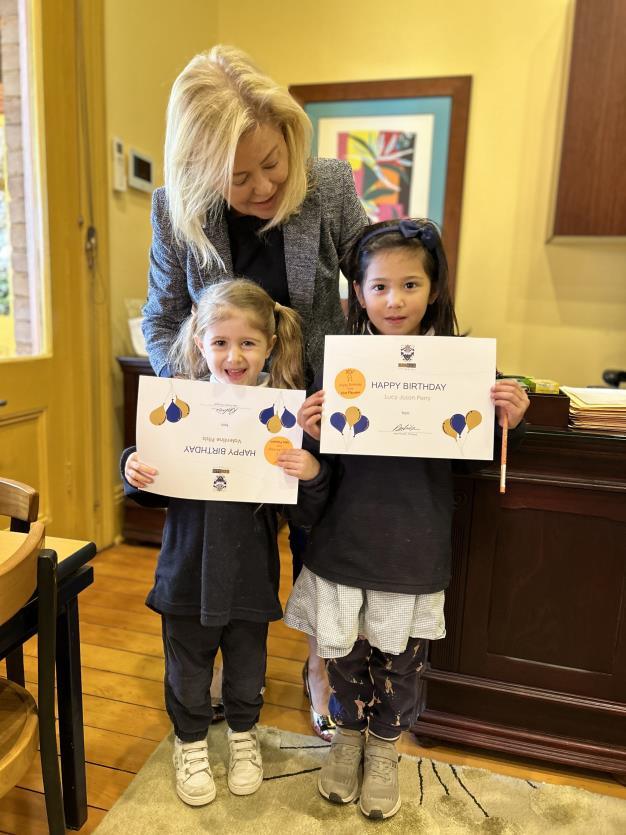
Our morning activities saw the children working on fine motor skills developing dexterity and control over small implements using nuts and bolts. This required patience and persistence in careful

building bilateral integration skills, as the children had to hold a nut in one hand and a bolt in the other. We also got creative with our nuts and bolts as we used them to do some painting. Little hands worked hard to dip and press the paint.
Active involvement and engagement in learning builds children’s understanding of concepts and their creative thinking and inquiry processes that are necessary for lifelong learning.

As we looked at our physical growth we examined how we make things grow. This week we focused on things that grow in different ways through construction: “tall” , “long” , “wide” etc.
Educators’ knowledge of individual children is crucial to provide an environment and experiences in which all children can participate and which optimise their learning and thinking.
Overheard conversations between children and teachers today during construction play:
“It’s getting very tall.”
“Build it up up up to the sky.”
“Tall tall tall to the sky.”
“It’s like a very long caterpillar.”

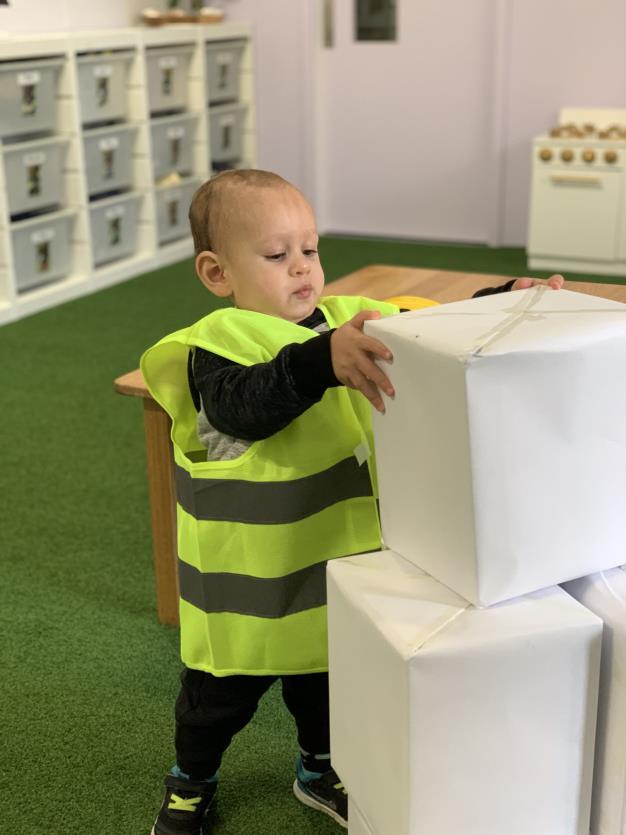

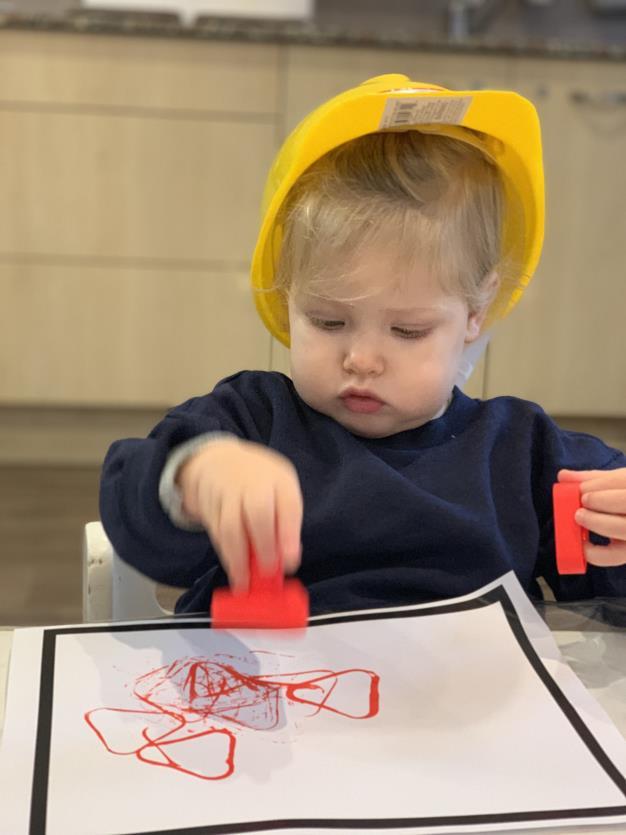




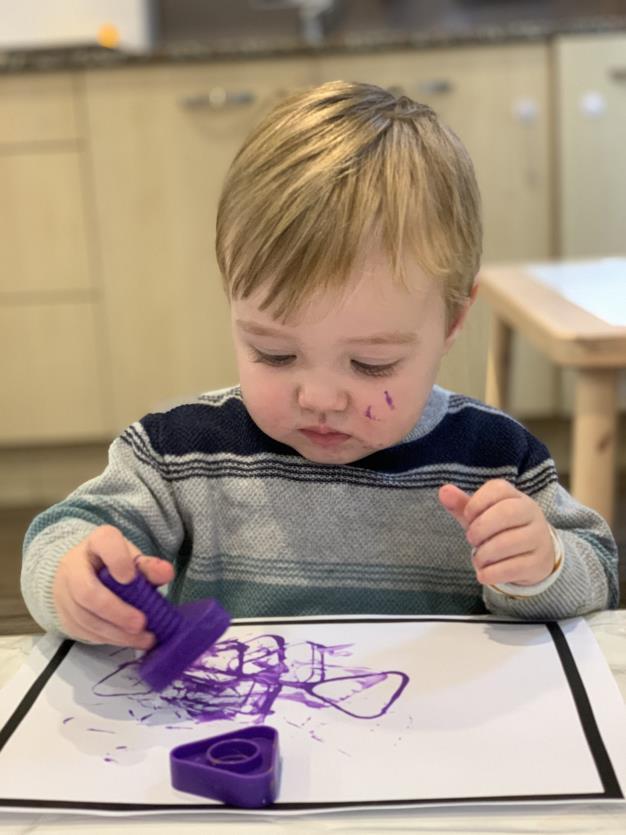







Fledglings


Exploring colours through painting
Over the past few weeks, we felt the need to focus our program on sensory experiences to provide the children with the opportunity to start learning about self-regulation. There are many benefits to sensory activities, especially for toddlers, who are just starting to learn about the world around them. They need to touch, smell, taste and listen to understand the immediate things happening. Through their senses, they develop language, social and emotional skills.
“The connections between children’s sensory, physical and motor systems are evident in the early purposeful activities of very young children who coordinate physical, sensory and cognitive actions to explore and learn about their world.” (Early Years Learning Framework, 2022)
This week, the children were invited to paint at the easel, using lots of different colours. As we continued to promote sensory experiences to our group, the easel was used to encourage the children to paint standing up in a vertical position, rather than sitting on their chair. While participating in this experience, the Fledglings could move around, using their whole body to go from one side to another of the surface they were working at.
The use of larger vertical surfaces allowed the children to use bigger arm movements, encouraging the development of strength and flexibility throughout the joints and muscles of the upper extremities of their bodies. When the children work on the easel, they will be closer to the surface they work on, fostering concentration, visual attention and hand-eye coordination.
At group time, we displayed the children’s artwork in the circle, so they were encouraged to appreciate their peers’ creations. We spoke about the kind of stroke we could see on the paper, the colours they used and their techniques.
Over the next few weeks, we will continue to explore sensory experiences and colours, combining these interests with another favourite experience in our group: gardening.
Learning Outcome 1: Children have a strong sense of identity. Children learn to interact in relation to others with care, empathy and respect.
Learning Outcome 2: Children are connected with and contribute to their world. Children become aware of fairness.
Learning Outcome 3: Children have a strong sense of wellbeing. Children are aware of and develop strategies to support their own mental and physical health and personal safety.
Learning Outcome 4: Children are confident and involved learners. Children resource their own learning through connecting with people, place, technologies, and natural and processed materials.
Learning Outcome 5: Children are effective communicators. Children interact verbally and nonverbally with others for a range of purposes.
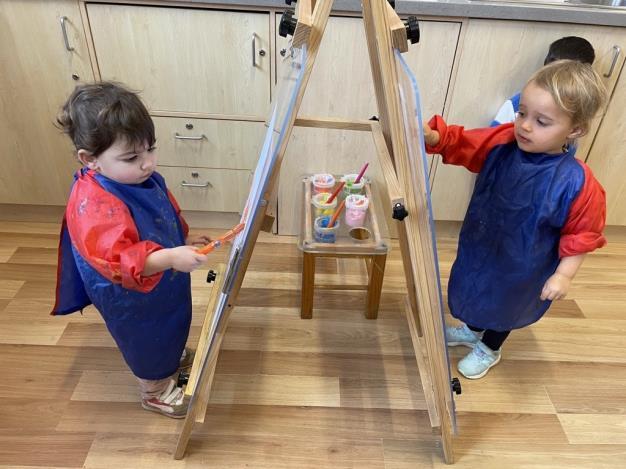

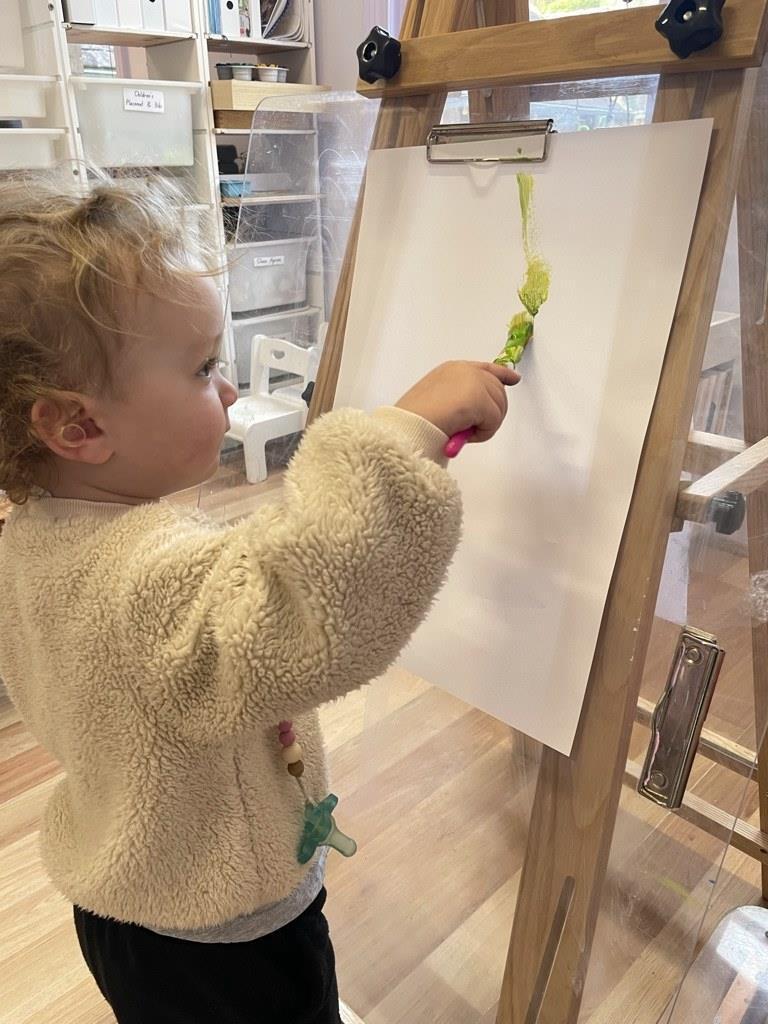








Stage 2
 Land Transportation
Land Transportation
On week 8 of Term 2, the 2R group focused on land transportation, especially the most present types of vehicles for the children, such as scooters, bicycles, motorcycles, cars, buses, trucks and trains. They were all mentioned in our conversations and were part of our activities for the last few days. Besides being possible to see some of these forms of transport through the window in our classroom, from time to time we also hear sirens of ambulances, fire engines and police cars that always cause excitement and curiosity in the group. The last point that makes land transportation interesting is that the children can ride some of them on their own, such as bicycles and scooters, which develops their confidence and self-esteem.
During our group time for the last two weeks, we explored the song ‘The Wheels on the Bus’ in different ways, such as posters and books, and we also engaged in story time where we practised rhythm, developed our language and learned a little more about rhymes.
As an art activity, this time we used pullback cars to create a group painting. The children were invited to participate in the dynamic in groups of 5, sitting around a blank paper in the shape of a wheel. Madeleine was very curious when Joyce was setting up the activity, so she asked, “What you doing?” Marcella said “Wow!” demonstrating excitement to be part of the activity and Wolf was trying to guess what the shape was, saying: “It’s a circle! It’s round!”
To encourage the cooperation, we provided one or two friction cars with different colours per group, this way, the children had to take turns to pass the car to another child of their choice, working on their hand-eye coordination and sense of direction. After a quick explanation of how to handle the cars, Levi repeated the words and movements, proud that he managed to pass it to whom he wanted to on his first attempt. For the last part of the activity, the children were invited to use the black paint so they could see the car tracks after they rolled the car to their peers.
These dynamics stimulate cooperation, while introducing opportunities to develop other cognitive aspects, such as creativity and coordination, which are always attractive to the children of this age group. It is great to see they are working on their skills, not only the way we planned for them to do during the activities, but also learning in ways we could never imagine they would.
Outcome 1.3: Children develop knowledgeable and confident self-identities.
Outcome 1.4: Children learn to interact in relation to others with care, empathy and respect.
Outcome 4.1: Children develop dispositions for learning such as curiosity, cooperation, confidence, creativity, commitment, enthusiasm, persistence, imagination and reflexivity.
Outcome 4.2: Children develop a range of skills and processes such as problem solving, enquiry, experimentation, hypothesising, researching and investigating.
Outcome 4.3: Children transfer and adapt what they have learned from one context to another natural and processed materials.
Outcome 5.1: Children interact verbally and non-verbally with others for a range of purposes.
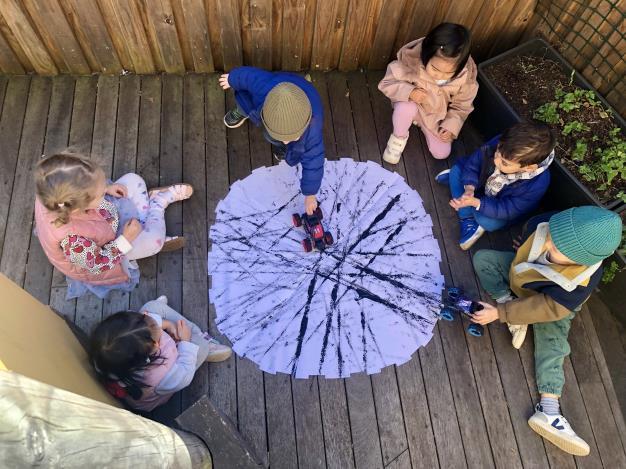







Stage 3


Who saw Turtle?
At the beginning of June it was National Week of the Ocean. The idea behind this week is to help to educate everyone on the benefits of the ocean as well as the dangers it faces from us. This makes people more conscious of the needs of the ocean. It protects marine life, and It reminds people that there are a lot of species that need to be protected. These species can only survive when we take better care of the ocean and keep the beaches clean. Everyone loves the beach and in our class there has always been a constant discussion on the sea creatures that call the ocean their home.
Following up from our story “Tiddalick” the children were introduced to the story” Who saw turtle?” by Ross Moriarty. It is a story that tracks the amazing migration of the turtles. As we talked about the lifecycle of the turtle the children were given the opportunity to participate in the ‘watch it grow’ series of a turtle egg. The children followed the instructions on the box as we all held the egg and felt how hard it was and then we placed it in a tub of water with some sea creatures to watch over it. The children were very excited by this as they showed everyone coming into our classroom the progress of the turtle in the egg, including friends who had been away on holidays. While we know that it is pretend, there is an excitement to see the turtle break through the shell as this replicates what a real turtle would do.
We had many discussions about the different creatures in the ocean as shown in the illustrations by Indigenous artist, Balarinji. We then worked on our own ocean art pieces. We used water colours for the background and the children went on to use scissors to cut coloured patty pans and string. We had bubble wrap to create jelly fish and octopuses, along with textas to be used for the children’s own drawings that they added to their version of “Who saw turtle?” The children were then invited to become an author as they shared their stories, and these were written down to accompany the art pieces.
We also added a jelly fish tank to our room, as this was one of the creatures that saw turtle in the water. The children helped to set this up as we took turns to add water to the tank and then we turned it on. The tank became alive as the two jellyfish started to move and lights in the tank helped to illuminate them. Benji asked the question “Do the jellyfish have gills?” We further investigated this with a YouTube fact video about the jellyfish. Did you know that jellyfish are older than the dinosaurs, have no bones, no brain, no eyes or ears? They have a mouth, and they blow bubbles to propel themselves along.
EYLF Outcome 2-Children are connected with and contribute to their world. 2.4 Children become socially responsible and show respect for the environment and use play to investigate, project and explore new ideas.













Stage 4
S is for Superhero
This week, the Stage 4M children explored heroes, heroines and villains. The children were particularly interested in superheroes.

There are many benefits to superhero play:

● Offers a great context for imaginative play and creativity.
● Provides opportunities for children to develop detailed storylines and narratives.
● Can engage all children in fantasy play.
● Presents children with opportunities to problem solve and resolve conflict.
● Helps children to explore the triumph of good over evil.
● Opens up conversations with children about everyday superpowers that we can all foster, e.g. resilience, friendship, listening skills.
● Is usually very physical and active and provides plenty of opportunities for gross and fine motor skills.
A small world set-up of superheroes has been in the classroom for the term. The children interact with this every day! It began with the superheroes fighting the crimes of the city’s fiercest villain, the monster shark. The children then began to transfer the superheroes to other areas of play. They used the magnets and the large blocks to make homes for the superheroes and even a headquarters. Then they became dens of the bad guys where the superheroes would be trapped. Superhero games extended to the playground where the children freely used their imaginations to create stories of superheroes and villains, dealing with the complex intricacies of good vs evil, right vs wrong.
Over the term, the children have been drawing and colouring-in their most beloved superheroes and villains. However, this week we focused a little more than just the superhero.
The love of superheroes was carried over into literacy this week. S is for Superhero! For group time, the children were invited to think of words that began with ’S’. They all sat in the circle making the ’s’ sound. They each put up their hands as they thought of a word. Once they got started they couldn’t stop. They sounded out 65 ’s’ words! What an amazing achievement. Harvey continued to sound out more ’s’ words throughout the day, too.
The children were all invited to the table to participate in the provocation artwork, and they were very excited to do it. First, they sounded out the letter ’s’, then they traced around the bubble letter. Once the children had finished tracing, they cut around their letter ’s’. They chose what colour piece of paper they wanted to stick their ’s’ on and then it was time to decorate. Then the children could decorate their ’s’ however they wanted. They used markers, pencils, crayons, and a range of collage materials such as mosaic squares, buttons, joggle eyes, mesh and crepe paper. These are on display on the board for all to see.

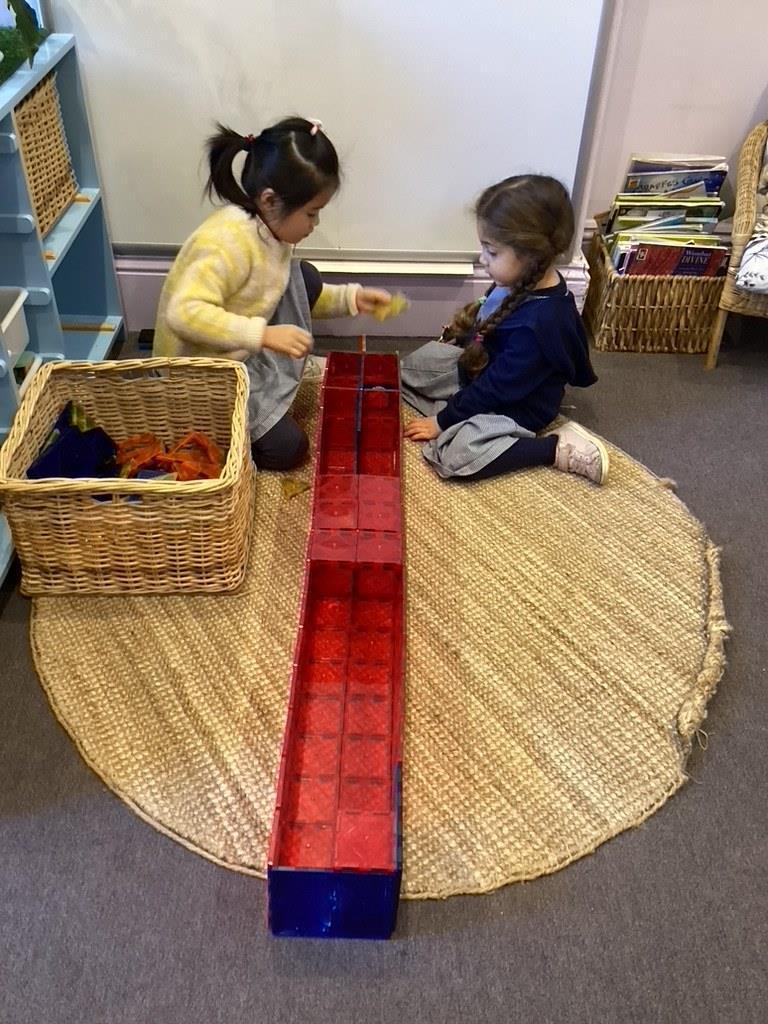




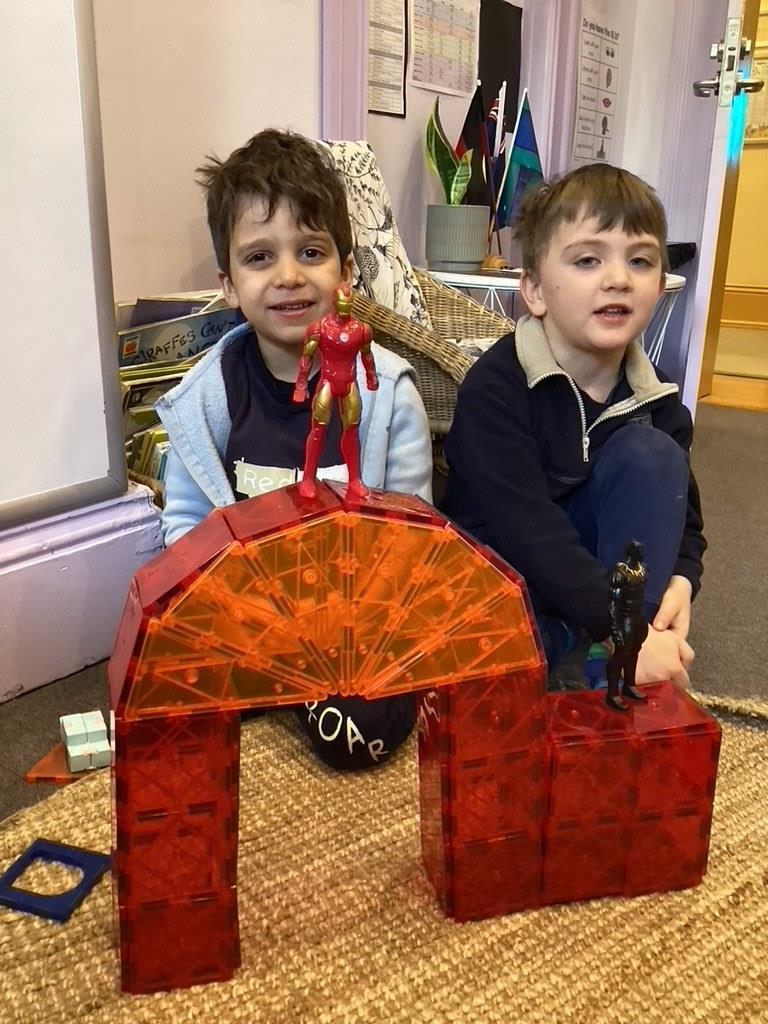












Connecting with Nature













Dance and Drama


This week in Drama the children explored how energy is necessary when performing and they learnt how to control and focus that energy. Every stage started with a warm-up called ‘shake out’, with all children standing in a circle with plenty of room in between each person. The children followed and counted with me whilst shaking out their right hand, left hand, right foot and left foot for 16, 8, 4, 2 and 1 counts. Alfie from Stage 2 wanted to do it super-fast, which was very funny, while James said that we looked like scarecrows!
Next, we discussed energy and excitement. The children named a few things that they get really excited about. Olivia in Stage 3 (Emily’s class) said ballet, while Eugine in Daniella’s class pointed at me! I explained that this excitement is the good energy that is needed while acting. Nobody wants to see boring actors who look like they are about to fall asleep!
In Stage 4 I asked a few children to stand up and give examples of having a lot of energy and then having low or no energy at all. I asked the other children to observe how mannerisms (facial expressions, body movement, voice levels) change as each child goes from high energy to low energy.
Next, we built an energy ball playing with the dimensions and throwing it up in the sky. We then ate our energy balls, so we had the visualisation of an unlimited supply to draw from whenever we need it. We talked about things that made us feel excited and how that can also be a resource to draw from, in generating excitement.
Lastly, we got up in groups of 1-3 and used mime to perform a mundane task such as brushing our teeth two times. The first was with low energy and then it was repeated with high energy. This helped to visualise the difference for the children. We talked about how it is more engaging for an audience to watch a performer who has high energy rather than one with low energy.
In the younger years we did some movement. I call this running a marathon. Everyone stands in a circle. I told the group that everyone is about to run a marathon, without moving from their spots (I gave them spots to stand on) in the circle. Here I reminded the children to control their energy so that they did not tire out before the race is over. We started out by pretending we were behind the starting line and had to warm up first. Everyone followed me in stretching and jumping jacks. I said, “On your marks, get set, go!” and everyone began running in place. I guided them by having them turn corners, pass cheering fans, swim through a lake, jump over a log, stop for the traffic and finally, cross the finish line. We also read the ‘hungry bullfrog’ story book which focuses on colours and animals as well as stimulating touch.
Excellent Drama everyone!

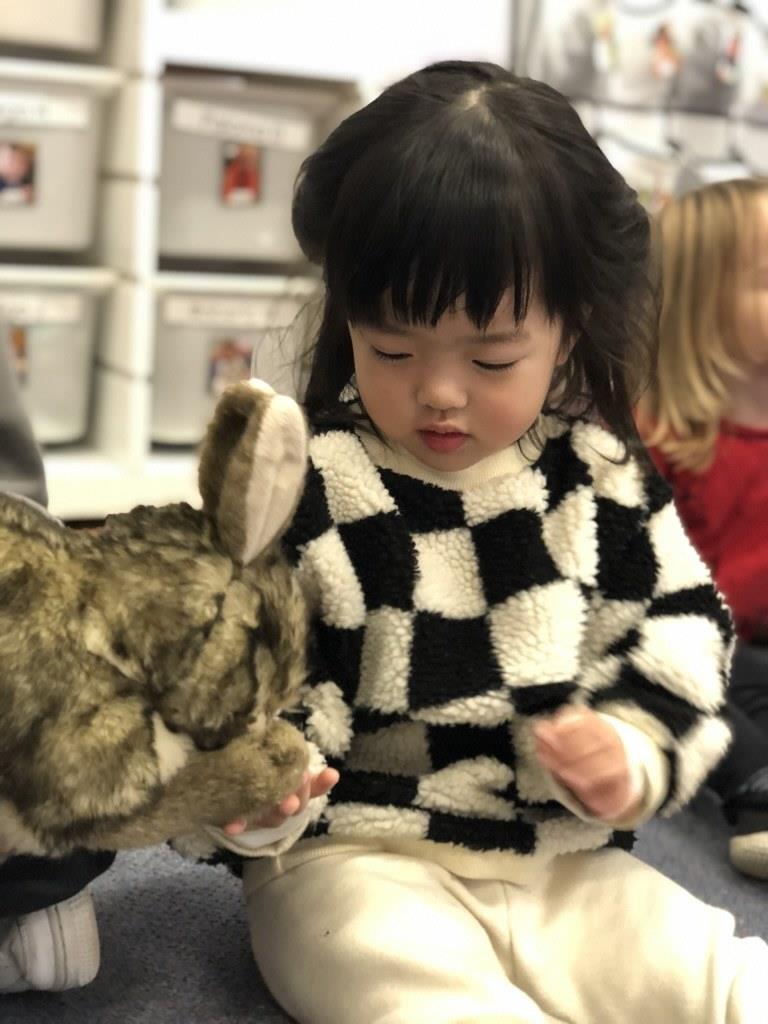
Music

Auditory Perception is our brain’s ability to perceive sound. It is important for a child’s growth because it helps to attach meaning to sounds, which helps adds to their ability to learning fundamental skills like speaking and reading. This week we used various activities or games in our lessons to help test our ability to listen and follow instruction.
We started our Stage 3 and 4 lessons with our scales and dividing the class into our blue and red maracas, after which we took turns at each colour, shaking along and singing our scales. We sang on ascending and descending scales, creating shapes for ‘MA’ and thirds on ‘YOU’. Some of our competitive youngsters wanted to make it a game and if you shook when it wasn’t your turn, you

were out. We revisited one of songs from the term –“Mr Sun”. With each class I started the song off, and then let the children continue singing, encouraging them to remember the rest of the lyrics and the actions on their own. We then took turn between red and blue at singing, as well as diving the colours for our “ABC Freeze”
Looking at our musical alphabet, we went over our 7 letters from A to G. We went through each letter and thought of other words which started with that letter or sound. We then used the Piano Play Mat to find the letters and stomp on the matching letter; in Stage 4, we also stomped out a to the rhythm of ‘dog – cat – spider - spider’
The activity everyone was most excited for this week was our drumming circle. Drumming circles are a fantastic way to help develop our listening, but also our visual-motor coordination. We started off by playing to a simple beat which slowly increased in tempo, and we called out either red or blue groups to play. Using dynamics, we played fast and slow, loud and soft – taking it in turns to call out our groups of red and blue. We revisited the exercise “I Can Play My Drum”, which relies on the children picking up on the concept only playing their drum when I say ‘drum’. Using our game ‘Around the Circle’, we passed the beat around by hitting our drum. Each time it came back to the beginning, we added another beat to see how high each class could get – I recorded their scores so we can see any improvements as the year goes on.
In Stage 2 and The Fledglings we began the lesson with our finger isolations from last week with “5 Finger Family” – trying our best to wiggle each finger individually. We sang through our warm-up counting and scales; Stage 2 doing ‘LA’ this week, which is pretty tricky to try keep our tongues in for some, and The Fledglings stick with ‘MA’
With our voices warm and ready, we sang through “Rock A Bye Bear”. The Fledglings were all up and dancing along, with our Stage 2 kids dancing with partners, and each time finding a new partner to dance with. We picked up our maracas to go out into the garden for “The Sunflower Song”, which never fails to get everyone moving and jumping along to the beat. We kept our maracas to help use work on our coordination as we shook and stomped along with “Mr Sun” .
To test our listening, we used blue and red scarves for “Twinkle Twinkle”, to see if the children were listening and would move to that side of the room with the matching scarf. In Stage 2, we even added pink and green this time, which is a vast improvement from the first time we did this exercise.
To end the lesson, we formed our drumming circle and started off with simple beats to follow before playing out ‘DOG’ , ‘CAT’ and ‘SPIDER SPIDER’. We explored our dynamics again with fast and slow, loud and soft; in Stage 2, we also separated the class into red and blue sides to see if they could follow the instructions and only play along when their colour was called. We ended the lesson with playing along to “In The Jungle”
Down in The Nest we began the lesson with our “Wake Up Body” , “Wheels on the Bus” and “Rock A Bye Bear” to get everyone moving on the frosty winter morning. We then took our maracas in hand to sing through “ABC Freeze”, using two maracas each to get both hands and arms shaking.
“Sleeping Bunnies” is much loved and never fails to get our little legs working.
We used our bells to shake along with “Bingo” and also “Twinkle Twinkle” – with some friends undecided on whether to shake their bell along with “Twinkle Twinkle” or do the actions. To end our lesson we also had some free play on our drums, beating our hearts out along with the music. I even tried to see if we could get everyone walking with their drums and playing them at the same time –baby steps.


This week was our second rugby lesson for our early learning students. This week, our little athletes continued their introduction to the game of rugby and focused on the basics of ball handling and passing. They were encouraged to work in pairs and to practise passing the ball back and forth, thereby developing their coordination and teamwork skills.
I introduced some fun games that helped the children to practise their new skills in a playful and engaging way. They had a blast running around, chasing each other, and practising their passes.
Overall, the second rugby lesson was a great success! I am thrilled to see the students growing in confidence and skill as they continue to explore the world of rugby. I look forward to sharing more updates with you as the lessons progress through the rest of this term.


